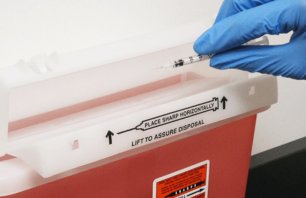With flu season upon us and COVID-19 infection rates increasing, healthcare facilities will most likely see a rise in patients suffering from illnesses caused by viral infections. One critical, yet potentially overlooked, component of care is how to handle and dispose of medical waste in a manner that helps to prevent the spread of infection.
Infectious waste is waste that is suspected to contain pathogens, which are disease-causing bacteria, viruses, parasites, or fungi. Examples of infectious waste include waste contaminated with blood or other potentially infectious materials, including unfixed tissues or organs.
There are several other types of waste generated in healthcare settings that may not be infectious, including:
- Chemical waste
- Pharmaceutical waste
- Cytotoxic waste
- Radioactive waste
Companies must be mindful when categorizing waste to not over-classify or under-classify. This means not assuming all waste is infectious, but also to appropriately identify and segregate waste that is infectious. The United Nations estimates that between 75 and 90 percent of the waste produced by healthcare facilities is non-risk (non-infectious and non-hazardous). Improperly classifying it can lead to higher waste management costs and potentially increased environmental impacts associated with unnecessary processing or treatment. Likewise, the failure to identify or treat infectious waste (due to under-classification) also creates risk, including the potential for secondary disease transmission due to exposure to infectious agents among waste pickers, waste workers, healthcare workers, patients, and the broader community where waste is improperly disposed.
Healthcare organizations should teach employees how to properly segregate waste to help protect their staff and other waste workers. Waste segregation best practices include:
- Segregating waste at the point of generation.
- Providing clarity in policies and standardized processes. (For example, organizations can use labeling and color-coding systems.)
- Separating sharps from non-sharps and placing them in sharps containers.
After waste has been correctly identified and segregated, there are additional important steps to follow in the storage, collection, transportation, and treatment phases.
Storage requirements may include, for example, using the universal biohazard symbol as a warning on the entryways to infectious waste storage areas and restricting access to those areas to a limited subset of trained employees. These types of practices can help prevent the spread of infection.
Once the waste has been collected and transported to an appropriate facility, it will undergo treatment processes, typically using steam or incineration to render the waste non-infectious. Most medical waste treated by Stericycle is subject to an autoclave process, where steam and pressure kill the pathogens. However, certain types of healthcare waste (such as pathological waste, trace chemotherapeutic waste, and non-hazardous pharmaceutical waste) are better suited for incineration and will be sent to the appropriate treatment facility per applicable law and Stericycle policy.
After infectious waste is treated, it is disposed of in a landfill according to applicable state and local laws.
Several regulators — including the federal Occupational Safety and Health Administration (OSHA), the U.S. Department of Transportation (DOT), and the relevant state agencies — regulate the segregation, storage, transportation, treatment, and disposal of infectious waste. All of these requirements must be followed. Being diligent about waste management early on in the process will help prevent the spread of infection and mitigate risks within your organization.
Learn how Stericycle can help you manage your infectious waste.
Frequently Asked Questions
What is regulated medical waste (RMW)?
What is considered RMW varies by state. The federal Occupational Safety and Health Administration (OSHA) defines regulated waste to include:
- Liquid or semi-liquid blood or other potentially infectious materials (otherwise known as “OPIM,” which includes any bodily fluid that is visibly contaminated with blood, all bodily fluids in situations where it is difficult to differentiate between fluids, and any unfixed tissue or organ.)
- Contaminated items that would release blood or OPIM in a liquid or semi-liquid state if compressed
- Items caked with dried blood or OPIM
- Contaminated sharps
- Pathological wastes
Should organizations manage medical waste differently if the patient is under some type of precaution?
In deciding how to handle patient waste under precaution, such as due to the flu, COVID-19, or C. diff, consider the following:
- How is the waste categorized?
- Category A waste has additional requirements to consider, but most infectious waste is not Category A
- In the case of medical waste resulting from the treatment of patients with influenza or COVID-19, that material can typically be managed along with ordinary infectious waste
- What are the regulatory requirements?
- Consider federal, state, and local requirements for managing the identified category of waste
- What are industry best practices?
- Your organization may utilize resources like the CDC guidelines to determine best practices.
- What role do your organization’s policies play in healthcare management?
- Consider whether your organization has a more stringent requirement than what is required by law
- Organizations may choose to have more rigid standards
- Do vendors have any applicable requirements?
- Certain vendors may have requirements or restrictions for accepting waste. Check their waste acceptance policies.



